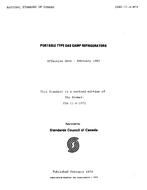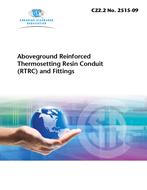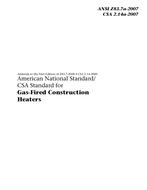Click here to purchase
Preface
This is the common CSA and UL standard for Extruded Insulating Tubing.
It is the third edition of CSA C22.2 No. 198.1 and the sixth edition of UL 224.
This edition of CSA C22.2 No. 198.1 supersedes the previous edition published in 1999. This edition of UL 224 supersedes the previous edition published in 1999.
1 Scope
1.1
This Standard specifies the requirements for insulating tubing that is usually round in cross-section and that consists entirely of extruded compounds whose characteristic constituents are thermosetting, elastomeric, or thermoplastic polymers (see Table 1 for materials and ratings).These requirements also cover heat-shrinkable and crosslinked tubing. A product for use at temperatures greater than indicated in Table 1 or a different polymer may be acceptable provided that
(a) it meets the performance tests in this Standard for a polymer that is similar; and
(b) long-term heat-aging tests are conducted as covered in UL 746B or C22.2 No. 0.17, using elongation as the primary property.
1.2
Tubing is intended for use only in air
– in dry and damp locations
– as part of the internal wiring of electrical devices and appliances in accordance with the Canadian Electrical Code, Part I (CE Code, Part I) and ANSI/NFPA 70, National Electrical Code (NEC).It may be used for insulating one or more inadequately insulated conductors, bus bars, motor leads, transformer leads, terminal lugs, or small assemblies of electronic components. Tubing is not intended for use in contact with sharp edges, corners, or projections, or where subject to tension, compression, or repeated flexing. Tubing is not intended for use where it is feasible to employ a standard insulated conductor (appliance-wiring material) intended specifically for the purpose.
1.3
These requirements do not apply to fabric tubing, chemically dilated tubing, polymeric tubing extruded with reinforcement, or tubing intended only for mechanical protection.
1.4
The acceptability of tubing in any particular device or appliance depends upon its acceptability for continued use under the conditions that prevail in actual service. Accordingly, for a particular application, it will in some cases be necessary to employ tubing having features other than or in addition to those specified in these requirements. For example, tubing may be required to have a heavier wall thickness or a flat rather than a round cross-section; it may be required to have inherent resistance to the effects of immersion in water, oil, solvents, or other liquids (or their vapors); it may be required to be used in an environment conducive to the development of fungi and similar organisms.
Product Details
- Edition:
- 3rd
- Published:
- 03/06/2006
- ISBN(s):
- 1554368448
- Number of Pages:
- 80
- File Size:
- 1 file , 700 KB
- Product Code(s):
- 2418285, 2417914, 2417914


